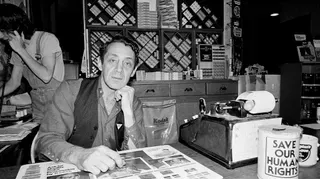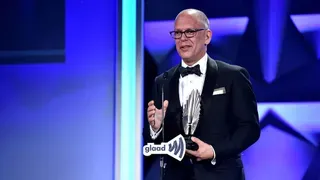April 5, 2015
Authors Praise Rise in LGBT-Themed Kids' Books
Kilian Melloy READ TIME: 4 MIN.
Twenty-five years ago, Leslea Newman published a book about a child and her two moms. A simple story about a little girl and her two mothers dropping her off to school. Titled "Heather Has Two Mommies," with illustrations by Laura Cornell, the book received both acclaim and controversy.
Named a Lambda Literary Award finalist in 1990, the book would spark outrage two years later in North Carolina concerning its place in the public library. But most importantly, the book became a milestone in LGBT-themed books and a perspective many children need to see.
Last month, a new edition was released to coincide with the milestone anniversary.
"When writing books for young readers, it's important to remember what it felt like to be a child," said Newman, 59, who identifies as lesbian and has written over 60 books. "Tap back to your childhood and write to children. There was no book [at the time] to reflect my family."
Since then, many books have been released with LGBT themes or authored by out writers.
Author Maya Christina Gonzalez wrote and illustrated a children's book called "Call Me Tree/Llamame Arbol." While the book, published last year, focuses on the main character's relationship to nature, it is known for not using any particular gender pronouns and uses both Spanish and English in its text.
"I started off writing, then with painting. The freaks and geeks need to tell their stories and kids need to hear them and relate to them. The big major publishers won't publish them," said Gonzalez, 51, a queer Chicana who lives in San Francisco with her husband and has made multicultural books for the past 20 years. "Without using gender pronouns, it gives my character the opportunity to grow into themselves. There's no reflection of that in the media."
Other authors write books using their own identity to shape their work.
James LaCroce, Ph.D., has tackled issues of gay adoption and environmental issues in his books. In the latest, "Chimpy Saves the Neighborhood," the plot revolves around a monkey named Chimpy and his best friend Matthew Chicken as well as his adopted parents, Juan and Benji. While touching upon environmental issues, the book also tackles LGBT hate crimes with Chimpy and Matthew Chicken building a robot because "their freedoms have been restricted."
"I wanted the plot of this book to concern community violence against the LGBT community in San Francisco. Even given all of our advancements (including gay marriage) there still is violence in our community," said LaCroce, 41, a gay man who's married to Bay Area Reporter assistant editor Matthew S. Bajko. "Particularly we still have violence against the most vulnerable of the LGBT community. When we begin to combat crime, we also look at how this restricts our freedoms."
LaCroce's book is a sequel to "Chimpy Discovers His Family," which was published in 2010.
Author Gayle E. Pitman, Ph.D., wrote "This Day In June," revolving around the importance of LGBT Pride parades.
"It occurred to me that I'd never seen a children's book about Pride before, and I thought that would be a fun, refreshing, and informative contribution to the LGBT children's book genre," said Pitman.
With illustrations by Kristyna Litten, the children's book provides an enriched reading guide and a note to parents and caregivers as Pitman anchors every two-page spread with information about LGBT history and culture.
"So much of our history is being lost or maligned in some way," added Pitman, 43, who identifies as pansexual and is a professor at Sacramento City College. "I was very surprised that almost nothing has been written about a guide for talking to children about sexual orientation and gender identity. When parents (especially if they're straight) don't know how to talk about these issues, they avoid them, and that's dangerous."
For many of the authors, having these issues open dialogue makes children more comfortable with themselves. Author Marcus Ewert published a story about a little boy named Bailey who dreams about making and wearing 10,000 dresses. Illustrated by Rex Ray and titled "10,000 Dresses," Bailey receives criticism from his family and friends about his choices.
"When I wrote the book in 2008, there were no books about trans kids and that needed to be addressed," said Ewert, 44, a gay man who will be a keynote speaker on the American Library Association's LGBT panel during its conference in San Francisco this summer. "At the time, people told me that no one in the world would publish ['10,000 Dresses']. It's not true now, as there are many books out there that are different. There is a mini publishing explosion of queer-themed books. It was the first book to be about a trans kid."
For all five writers, they are pleased that there is now more diversity in LGBT children's books, but Newman, for one, feels that movement has been slow.
"There's some progress but it's not enough," said Newman. "We need more diverse books when it comes to issues of race, disability, religion, and gender. I hope to see a lot of progress in the future very quickly."
As Newman's iconic work celebrates 25 years, she is not alone in telling stories of the LGBT community. As she reflects back on her work, she imagines that little Heather and her mothers would be all grown up in a better world.
"The mothers would be in their early 50s in their respective careers as doctor and a carpenter," Newman said. "Heather would be 30 years old and a feminist. She would be very happy and loves doing what she does."
Kilian Melloy serves as EDGE Media Network's Associate Arts Editor and Staff Contributor. His professional memberships include the National Lesbian & Gay Journalists Association, the Boston Online Film Critics Association, The Gay and Lesbian Entertainment Critics Association, and the Boston Theater Critics Association's Elliot Norton Awards Committee.





